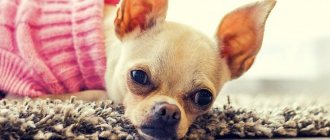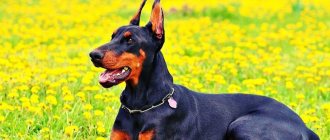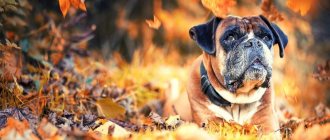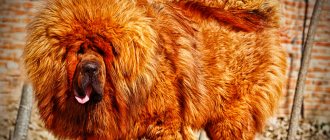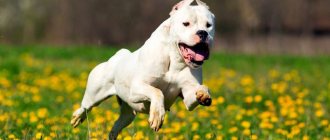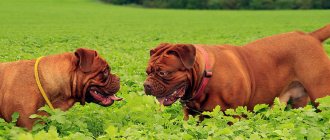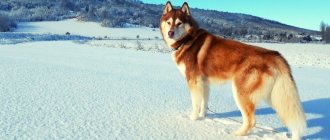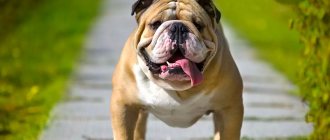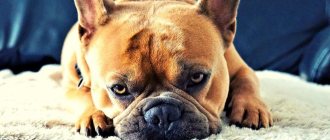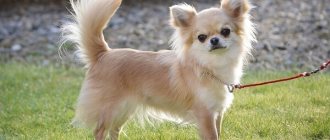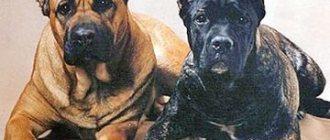The character of a dog depends on heredity and breed characteristics, but proper upbringing and training is also of no small importance. In this article we will tell you about the natural characteristics of the breed and how to properly start raising and training your pet.
The Pharaoh Hound is an ancient dog breed that has changed little since its development over 5,000 years ago. It was the dog of kings and may have been used to hunt gazelles with the pharaohs, hence the name of the breed. This faithful hunting companion later made its way to Malta, where it is now the national dog.
- Country of origin : Malta
- Height at withers : female: 53–61 cm, male: 55–63 cm
- Weight : female: 18–27 kg, male: 18–27 kg
- Lifespan : 12-14 years
- Use : companion dog, hunting
- Other names : kleb-tal-fenech
Content
- The main character traits of the Pharaoh Hound: female or male?
- Pharaoh Hound character
- Basic commands
- Raising a dog
In this article you will learn what features of character and behavior are inherent in the Pharaoh Hound. After studying this information about the temperament and disposition of the Pharaoh Hound at different ages, get an idea about the breed. Find out how the character of a bitch differs from the behavior of a dog. We hope our article will help you figure out which gender of puppy is best for you.
The main character traits of the Pharaoh Hound: female or male?
The Pharaoh Hound puppy is an active and restless pet. If you take care of and train your puppy, you can avoid pampering. Constant damage to things does not indicate the baby’s bad character, he is just very active and needs somewhere to throw out his energy. You can buy toys for him, he will be active with them, direct his energy to playing with them. Already from 3-4 months (the time of socialization), he is able to perceive the general rules of education. At this time, it is important to begin socializing and training the dog.
Bitch: character
There is an opinion that Pharaoh Hound bitches have a more submissive and gentle character. But experts believe that character largely depends on heredity and individual characteristics. There are always exceptions, bitches with a very difficult character, and there are males with an easy-going and submissive character. But still, there is a difference in the behavior of the sexes. There are advantages and disadvantages for female and male genders.
Advantages:
- Strong relationship with owner and home
- Emotionally sensitive perception
- Girls are smarter and smarter than boys
- Accepts training tasks well
- During walks, he runs less in the bushes
- Doesn't rush at strangers
- The breed is ideal for breeding, just one assessment from the exhibition is enough
Flaws:
- Sly
- Periodic menstruation
Owner reviews
Despite the menacing and aggressive appearance, the owners of the Canary Mastiff note that it is a fairly calm, affectionate and even slightly phlegmatic dog.
Below are a few points from Dogo Canario owners:
- excellent bodyguard;
- strongly attached to the owner;
- smart;
- not used to barking;
- an unusual, beautiful dog, very dexterous and strong;
- gets along well with other pets;
- The dog has little hair and is easy to care for.
Great Dane owners unanimously declare that this dog is the best for guarding the house, protecting the owner and the whole family.
The breed described above is still most suitable for experienced owners, since the dog is intended for protection. It should not be started by physically weak and elderly people.
The Canary will become a faithful friend and helper for both married couples and singles; the main thing to remember is that it should be given attention, nurtured, properly cared for, and then the pet will love its owner and be incredibly devoted to him.
Male: character
Advantages:
- High performance, very durable
- Solid appearance, a big plus for exhibitions
- Persistence in achieving results in the learning process
Flaws:
- Independent and more stubborn than a girl. Requires more strict training than a girl.
- To fulfill your physical and natural needs, you need a longer time for walks. According to physiology, he is not capable of quickly emptying the bladder.
- Can run away from its owner if it smells a female in heat.
- During the period of estrus in females, fights with other males are possible.
Rules for caring for pets
Regarding hygiene, here pharaohs compare favorably with representatives of other breeds. For her, getting dirty while walking is practically nonsense; they are skillfully able to bypass dirty areas and puddles, but if somehow your pet gets dirty, then you can’t do without taking a bath.
In fact, this dog willingly bathes under the supervision of its owner without fear of water, but you should make sure that the pet does not taste the shampoo, as this may have a bad effect on its digestion. Pharaohs do not need frequent bathing, as they have surprisingly short and neat fur, which also does not need to be trimmed or combed. This is very rare; many owners of other breeds suffer from frequent shedding of their pets and ubiquitous fur.
Ears do not require special care, but periodically it is necessary to clean them of earwax with special dissolving preparations.
It is recommended to brush your pharaoh hound's teeth twice a week with a special toothpaste for dogs.
Particular attention should be paid to your pet's claws, trimming them once a month. This must be done so that the nail plate does not interfere with running, because this breed of dog is a hound, and the comfort of the paw pads is very important for it. After walking around the city in the cold season, it is recommended to wash their paws with warm water, because the sidewalks are often sprinkled with various reagents that can harm the dog.
Is it possible to influence and correct the character of the Pharaoh Hound?
Raising and training a Pharaoh Hound is of great importance, as soon as you bring him into your home. Do not allow people to chew things, stop attempts to pester strangers while walking, do not allow them to eat from someone else’s hands, pick up food from the floor, or beg for food from you while eating. It is forbidden to jump on and bite people, even to show your love. Only training and proper upbringing will change a dog’s character for the better. The puppy training process is based on the method of motivation, encouragement and praise. It is prohibited and unacceptable to treat the dog harshly during training.
What you can learn
You already know how to use a dog clicker. And for what cases will it be needed? What you can teach your dog using the device:
- Good manners.
- Agility and obedience techniques.
- Standard commands.
- Prepare for exhibitions, competitions, hunting.
The clicker is even used to train service dogs. It is suitable for both a very small puppy and an adult animal. How effective is a clicker for dogs? Reviews from dog handlers say that the method works and is becoming more widespread.
Pharaoh Hound character
The Pharaoh Hound is alert, intelligent, friendly, gentle and playful.
- Affectionate
- Smart
- Communicative
- Playful
- Active
- Trainable
How to raise a Pharaoh Hound puppy
If you train your pet correctly, then over time you will get an obedient dog that will follow all commands and delight you every day. Experts believe that several factors may influence the Pharaoh Hound's susceptibility to following various commands:
- pet's temperament - the speed of the pet's reaction to stimuli, both positive and negative;
- character - how exactly the dog resists various unpleasant influences;
- obedience - the dog’s ability to accept human leadership;
- vigilance - the speed with which the dog notices potential danger, both in relation to itself and in relation to the owner;
- aggressiveness - the pet’s ability to react hostilely to potential danger;
- curiosity - interest that is developed when a dog feels, hears and sees something;
- sociability - the ability to interact with people;
- possessiveness is the interest shown by animals in certain objects, for example toys.
How quickly your dog will learn commands depends on which specific traits predominate in the character of the Pharaoh Hound puppy. By paying attention to the character traits of your animal, you can find an approach to it and adjust its behavior in certain situations.
- Eagerness will get you nowhere . You should not try to teach a Pharaoh Hound puppy all the commands at the same time; you need to learn the commands one by one. You need to have patience and act methodically. You should not scold your pet at the moment when he makes mistakes, and when he succeeds in something, then the pet should be encouraged.
- Don't hit . It is prohibited to use physical punishment against a pet. You should limit yourself to variable intonation, but avoid shouting. Once the Pharaoh Hound puppy is three months old, it is allowed to use a light spank as punishment while saying the phrase “Ew.” It is necessary to punish immediately when the animal commits an offense, and not after it, since the animal simply will not understand what exactly it was punished for.
- Subsequence . The main goal is to ensure that the pet follows the command the first time. Commands should be pronounced clearly and in an even voice so that the dog understands and obeys you. All family members should be involved in raising the dog, but they must act together. It is forbidden to allow situations in which you scold the puppy, and another family member praises him or simply does not pay attention.
- Pamper . Remember to reward your Pharaoh Hound puppy with a variety of treats and praise when he has completed what is required of him.
What it is?
Clickers have been used for dog training relatively recently. In Russia, this training method has not yet become widespread, but there is interest in it, and the device can be bought at every major pet store. But in its homeland, in the USA, this method is considered extremely effective.
The idea of using a certain sound during training came to dolphin trainers. A whistle was used as a sound signal. This method was adopted by dog handlers. The pioneer of clicker training is Karen Pryor.
The clicker is a small box with a metal tongue inside. When you press on the tongue, a click is heard. This is a simple device, it does not emit any rays, does not emit ultrasound, and does not shock the dog. No negative impact on the animal! Nevertheless, the use of the device is extremely effective!
Basic commands
You will use some commands more often, others less often. But they will still come in handy to easily interact with the Pharaoh Hound and even keep him safe in various situations.
- Aport. One of the most difficult teams. Many people perceive it as very easy and simple, but with many dogs you will have to work hard. This skill is used for other exercises: searching, searching, selecting an item and many others. Usually they are all used in service. When working out a command, “Aport” and “Give” are used, and a gesture is also used.
- Give. On the command “Give” the dog must give up the object.
- Lie. A connecting command that needs to be learned for other commands. In addition, it will not interfere at home or on the street.
- To me. You will need to use this command quite often. So start with this immediately after your Pharaoh Hound puppy has learned his name. Never call the dog to punish, and do not scold if it comes on its own, even after mischievousness before it. This behavior on your part may alienate the animal.
- Place. A puppy or an adult dog must clearly know where his place is located. He can sleep anywhere, if you allow it, of course, but he must know this command. You can use it outside the home, marking the place with a leash or your favorite toy.
- Near. It is possible to teach your pet the “Near” command at any age, be it an adult dog or a small puppy. When you move to a new home, you should immediately think about training your puppy.
- Sit. One of the very first commands that a Pharaoh Hound puppy should learn.
- Stand. The command is useful in everyday life, for example, for combing a dog.
- . The prohibiting command is one of the most mandatory and taming it begins from the first day the puppy appears in the house. Requiring the command “Fu!”, “No!”, “No!” - immediately stop the unwanted action.
Breed standard Dogo Canario
Presa Canario resembles a Cane Corso with its molossoid, distinctly brutal appearance. The breed's weight category is also serious: a proper male must gain at least 50 kg of live weight, while females are allowed to stop at 40 kg. “Girls” also have other external differences. For example, females have a more elongated body format. In addition, they are much shorter than their partners: only 56-61 cm versus 64-68 cm noted in males. The “wild” tiger color adds texture and charisma to the breed, as well as small folds of skin on the face, reminiscent of its mastiff ancestors.
Head
The strong, massive head of the Dogo Canario has the shape of an elongated cube. The ratio of the length of the skull to the muzzle is approximately 60:40. The skull is moderately convex with prominent cheekbones, a smoothed occipital protuberance and freely hanging skin. The stop is quite noticeable, but not steep, with a well-defined middle fold. A characteristic feature of the breed is a flat, straight muzzle with a wide base, only slightly tapering at the tip.
Teeth, jaws, lips
When they touch each other, the lips form an inverted V shape, with the upper lips hanging down slightly. The jaws are massive with developed fangs, large molars and relatively small front teeth. The standard bite types are scissor bite and tight bite. Direct jaw closure is acceptable, but undesirable, as it contributes to tooth abrasion.
Nose
The brightly pigmented lobe with large nostrils is stretched wide. The front of the nose protrudes slightly above the dog's lips.
Eyes
The Dogo Canary has large or medium-sized eyes that are harmoniously set - that is, not protruding, but not deep-set either. The eyeballs are covered by dense, brightly pigmented eyelids. The classic color of the iris is from chestnut to dark brown.
Ears
The ears, hanging freely on the sides of the skull, are far apart from each other. The ear flap itself is small in size, closely fitting to the head and, when folded, resembles a pink petal. Often the ears are cropped, in which case the organ takes the correct standing position.
Neck
The Dogo Canario's neck resembles a cylinder with well-developed muscles and a slight dewlap in the front.
Frame
The body of a purebred individual must be massive, strong and exceed the height of the animal at the withers in length by at least 18-20%. The back is straight, but with a slight rise between the croup and withers. The croup of Great Danes is developed, and this part of the body looks more massive in females. A mandatory requirement of the breed standard is a wide chest with strongly arched ribs and a slightly tucked belly line.
Limbs
Dogo Canarios have muscular, parallel limbs that provide an elastic, long stride when moving. The breed's shoulders are set at the correct angle, the elbows do not turn out to the sides, the pasterns are massive with a slight bend. When viewed from the rear and sides, the animal's thighs appear elongated and muscular, and the hocks appear low. All four paws have tightly pressed, rounded toes and hard black pads, with the front paws being shorter than the hind paws. Claws are always black.
Tail
The Dogo Canario's tail has a medium set, it is very massive at the base and tapered at the tip. A calm dog has a tail that hangs down, but does not reach the hocks; in an excited one, it takes on a saber shape, rises towards the back, but never curls.
Wool
Formally, “Canaries” do not have undercoat, but in practice it can be found in the neck and buttock areas. The outer hair is short, even and hard. The longer hair is on the hips and withers, the shortest is on the outside of the ears.
Color
Traditional colors of the breed are all types of brindle: from light gray to warm shades. Additionally, the standard allows the breeding of fawn and sand colored individuals. There is a black mask on the Dogo Canario's face. In addition, there may be contrasting white markings on the neck and toes, which are undesirable.
Disadvantages and disqualifying vices
An ideal show pet must fit into the parameters specified by the standard in all respects. If the dog has noticeable defects in appearance, such as general fragility of appearance, atypical skull shape and disturbed proportions, this will greatly affect the exhibition rating. As for the ban on exhibiting, a Dogo Canario that has the following appearance defects can receive it:
- heterochromia or too light eyes;
- white marks on the fur in places not specified by the standard;
- undershot;
- no black mask;
- depigmented skin of the lips, eyelids and earlobes;
- keeled chest;
- cryptorchidism;
- the croup below the level of the withers.
Individuals with docked tails and those with atypical behavior are not allowed for exhibitions and breeding. Usually these are overly cowardly or aggressive animals that are difficult to control in the ring.
Raising a dog
Education is the process of shaping the behavior of a Pharaoh Hound acceptable to the owner, when this behavior is not regulated by commands.
During upbringing, a dog develops relationships with its owner, family members, passers-by, behavior in the house, on the street, and relationships with other dogs. The training process begins immediately when the dog first appears in the house and continues throughout the dog’s life. Regardless of the dog's breed, it must be trained. Just as people do not like ill-mannered people, dogs should also know what is allowed and what is not allowed. Raising a dog is a rather complex process, which is not limited to learning just a few commands. The main goal of education is that the dog should become pleasant to talk to. In addition, it must be manageable at some points, otherwise it will be very difficult for the dog owner. In the broadest sense of the word, dog training is about teaching the dog commands such as “Bad” and “No”. But besides this, the dog must know what is good and what is bad, even in those moments when the owner is not around. Some believe that the Pharaoh Hound only understands commands, but cannot generalize. Only those who, as a rule, never had dogs, and studied them only in laboratory conditions, in which dogs were not able to show their full potential, are convinced of this, as well as those who, due to their personal qualities, were unable to establish a relationship with pet. In real life, the Pharaoh Hound is a pack animal and therefore, like any other pack animal, needs to communicate with members of its family. In this situation, the dog’s family members are people. It is quite stupid to think that if a dog caresses you, this means that his skin is itching. In order for a dog’s nervous system to function normally, it needs affection, love, communication, and praise. In addition, so-called “inhibiting factors” are required, because if the dog is allowed everything, then this will not lead to anything good. When raising a Pharaoh Hound puppy, you should pay attention to the genetic characteristics of the breed. A family is a pack in which there must be a leader, in this case the leader is a person. The leader punishes, plays, feeds, caresses, praises and scolds. All other members of the owner's family are ranked by rank. At that moment, while the puppy is small, all other family members are senior to him. However, in the process of growing up, around the age of one year, the dog begins to look for its place in the hierarchical pyramid. Naturally, she will try to take the step that is as high as possible. She can do this with the help of force, in the case of large dogs, or with the help of cunning, as small dogs do. The more ill-mannered the dog is, the more difficult this process will be. If the owner from the first days shows his pet that the one who has the power is right, then he will turn out to be a frail neurotic or an evil beast with whom you will hardly communicate with joy. A Pharaoh Hound puppy must understand that he must obey people, since they love him, feed him, and raise him. Understand that prohibitions are not the whim of the owner, but a way to protect everyone from trouble. The main influence on the dog should be the voice. From the first days of being in your home, the puppy must realize that you love him, and if you raise your voice, then this means that he is doing something wrong. One of the best incentives for a pet is considered to be a treat, which should be given out for good behavior and listening to commands. The character of the Pharaoh Hound: who is better to take a bitch or a male
History of the Dogo Canario breed
The origin of the breed occurred on the islands of Tenerife and Gran Canaria. It is believed that the cattle dogs Mahorero, bred since ancient times by the Guanche tribes, as well as the Roman Molossians, which were brought to the Canaries later, took part in the formation of the genotype of the animals. For a long time, Presa Canarios bred freely in the territories of the archipelago, and their main area of activity was protecting the owner’s property and grazing livestock.
In the 15th century, the Canaries were appropriated by the Spaniards, partially exterminating and partially sending the indigenous population into captivity. The military conflict also affected dogs. In the devastated ashes, the animals had nothing to guard, so a new job was invented for them - fighting and baiting wild animals. Thus, Canary dogs retrained as gladiators who staged public performances, which at first were not particularly cruel.
Aggression and suspicion came to the breed later, when its representatives were pumped up the gene pool by crossing Presa Canario with English bulldogs and mastiffs brought to Tenerife. The offspring from these matings had great viciousness and reaction speed, so the Spanish authorities considered the breed dangerous, allowing it to be kept only by butchers. Individuals belonging to owners of other professions were destroyed. Great Danes continued their fighting career, for the sake of which they were bred with other four-legged “aggressors” such as Staffords and Boxers. Subsequently, this led to the loss of the animals' native appearance and stratification into breed types.
Since the second half of the 20th century, dog fighting was banned, and the Dogo Canario family fell into decline. Perhaps the breed would have disappeared if Spanish enthusiasts had not taken up the challenge of reviving it. The animals' phenotype was once again updated, adding the genes of Rottweilers, Great Danes and Mastino Neapolitanos, and in 1982 the national Presa Canario club began operating. In 1986, the first exhibitions of Dogo Canarios started in Spain, in 1989 the breed was standardized, and in 2001 its representatives were officially registered by the FCI.
